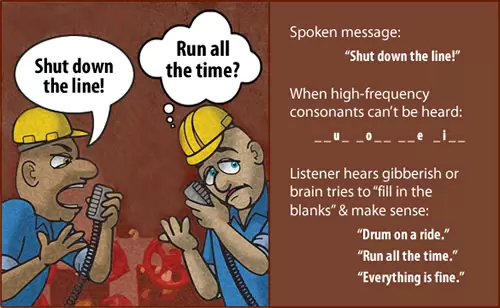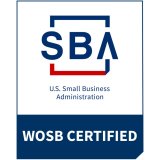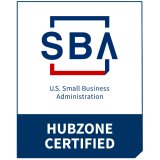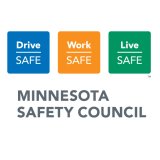Special Considerations for Workers with Hearing Loss
How many times have you seen employees break the seal of an earplug or earmuff because they can't communicate in the workplace? Individuals who are hard of hearing are often the worst offenders. Not only are these workers at risk of exposing themselves to hazardous noise, but communication typically isn't even improved. So what can we do to help?
According to the National Institutes of Health, approximately 17 percent of American adults report some degree of hearing loss. That's roughly 36 million people. Over 20 million Americans experience tinnitus, or annoying ringing in the ears. In noisy workplaces, individuals with hearing impairment face special challenges such as communicating with co-workers, detecting warning signals during emergencies, and working safely around motorized vehicles and heavy machinery. For people with severe hearing loss or hearing that is significantly worse in one ear, a common difficulty is localization. That is, the person may hear a sound, but not know which direction it's coming from...a real problem in situations where auditory alerts such as forklift back-up alarms are crucial to safety.
Another concern in noisy environments is that conventional hearing protectors may degrade speech audibility for hearing-impaired workers. Namely, conventional earplugs and earmuffs provide more sound reduction for high pitch sounds than lower pitches. In speech, vowel sounds (a, e, i, o, u) are fairly low in pitch, while consonants (such as k, s, t, f, sh, etc.) are higher pitched. For a worker with high frequency hearing loss (very common), wearing hearing protectors can exacerbate the high frequency deficit, and in turn, speech intelligibility is reduced. A common complaint for people with hearing loss is "I can hear you talking, I just can't understand what you're saying." Experiencing a hearing loss can be like reading a newspaper with holes in it. For those with high frequency hearing loss, missing out on the consonants of speech can leave the listener struggling to interpret vowel sounds that come across as mere mumbling or gibberish. Often listeners misinterpret consonant sounds; usually the brain tries to "fill in the blanks," sometimes arriving at inaccurate interpretations. Resulting miscommunications day to day can range from harmless to heartbreaking. In an industrial or first responder situation, miscommunications can affect job performance and efficiency, and can be dangerous, even deadly. The following is an example of how hearing loss (or loud background noise) can seriously affect speech communications on the job.

For these reasons, it is important for companies to consider ways to address the special needs of their hearing-impaired workers. Options to consider:
Develop visual cues: Where obstructed vision is not a problem, consider developing a system of hand signals or written text to clearly convey messages without relying on auditory communication. For emergency alerts, investigate alarm systems with flashing lights or vibrating pagers.
Create pre-coded messages: In advance, develop a predetermined set of short, predictable code words and key phrases for your most typical operations. Expected messages are typically easier to recognize than novel communications.
Improve the listening environment: There are two basic ways to improve an individual's ability to hear in noise: 1. increase the level of the speech or warning signal and 2. decrease the level of the background noise. Engineering controls in the workplace may help decrease noise at its source. The other part of the equation can be more difficult. For face-to-face communication, there is a physiologic limit to how loud and how long a speaker can shout to be heard. Cranking the volume of a PA system above loud background noise may help detection, but potentially adds to noise exposures for all workers in the area.
Utilize specialized hearing protectors: Another solution is to provide employees with specialized hearing protectors that block out background noise without compromising the speech or warning signal. Although these protectors are not hearing aids, by their design they often improve communication capabilities for all, including those with hearing loss. Options include:
Communication headsets/earsets: These systems consist of a standard hearing protector (earplug or earmuff) that attenuates or blocks the noise, in combination with a small speaker imbedded in the earplug or muff to deliver the communication signal directly to the ear. Systems may be designed for one-way or two-way communication. There are a variety of products in the marketplace with pros and cons to consider, including comfort and compatibility with other personal protective equipment. When it comes to communication effectiveness, there are two important features to look for:
1. Binaural (both ear) listening provides a significant advantage over monaural (one ear listening). Our auditory system is clearly designed to work with input from both ears. The brain processes and compares signals from each ear for localization, understanding speech, and separating speech from background noise. Most research studies agree that the more complex the signal, the more complex and loud the competing background noise, and when fewer visual cues are available, the binaural advantage is most robust. As a result, signals such as radio transmissions don't have to be as loud if a listener is using both ears. The practical result of this phenomenon is that volume settings typically don't need to be as high if using a binaural headset compared to one with a monaural listening configuration.
2. Output limiting promotes safer listening levels. Whether a worker has normal hearing or hearing loss, it is important that signals delivered to the ear do not add to a noise hazard on the job. When purchasing a communication headset for any employee, make sure the device has an electronic feature to limit outputs to safe levels. Again, a binaural listening feature allows most users to choose a lower, safer, listening level than would be possible with a monaural system.
Flat or uniform-attenuating hearing protectors: Special filters imbedded in these earplugs or earmuffs are designed to block out high and low frequency sounds nearly equally. Workers with high frequency hearing loss may find these filters helpful.
Level-dependent or non-linear devices: These hearing protectors block louder sounds such as gunfire, but still let in lower level sounds either through special filters or electronic circuitry. Electronics may even amplify quiet sounds, so it is important to choose only devices that limit amplification to safe levels. This type of device is especially helpful in intermittent noise environments where extended periods of quiet are common.
Hearing Aids: Some hearing-impaired workers own hearing aids and ask if they can wear them in noisy workplaces. It is important to remember that hearing aids amplify all sounds, speech as well as unwanted background noise. As a result, hearing aids typically should not be worn in loud noise environments. Even if turned off, hearing aids are not designed to be hearing protectors. OSHA has issued a letter of interpretation stating employees with hearing loss "cannot satisfy the requirement to wear hearing protection simply by turning off their hearing aids when working in a high noise area." (OSHA, 8/3/04). There is one more option to consider. In rare cases, it may be possible for a worker to wear hearing aids (volume set at a safe level) underneath earmuffs. One study showed improvements in speech intelligibility for this configuration, but warned that an audiologist would need to make the determination on a case-by-case basis and that employees should be monitored closely (Verbsky, 2004 - CAOHC Update). A potential drawback with this option is the possibility of acoustic feedback (squealing) when a hearing aid is covered, making this option impractical in some cases.
Hearing conservation: Some companies mistakenly believe that it's too late to intervene if a worker's hearing abilities are "too far gone." But even individuals considered severely hearing impaired or "deaf" typically have some residual hearing. It's important to protect any remaining hearing the worker may have. For best practice suggestions, see OSHA's Safety and Health Information Bulletin 12-27-2005: Hearing Conservation for the Hearing-Impaired Worker
Individual review & accommodations: Because job requirements vary and workers' hearing abilities differ, consider developing job-specific protocols for hearing-critical jobs and individualized plans for your hearing-impaired workers. Emergency preparedness, alerting device options, and training accommodations are all important considerations. For best practice suggestions, see OSHA's Safety and Health Information Bulletin 07-22-2005: Innovative Workplace Safety Accommodations for Hearing-Impaired Workers. The U.S. Equal Employment Opportunity Commission (EEOC) provides technical guidance regarding workers with hearing loss under the ADA: Hearing Disabilities in the Workplace and the Americans with Disabilities Act, EEOC-NVTA-2014-1, 1-24-23.
If you would like to learn more about improving listening in noise, more resources are just a click away:
Communication demonstrations: Check out CavCom‘s video demonstrations of filtered hearing protectors and radio communications in high noise areas.
Contact CavCom for more information about improving your company's productivity, safety, and communication capabilities.
| Categories: | Communication in Noise, Hearing & Hearing Loss |





